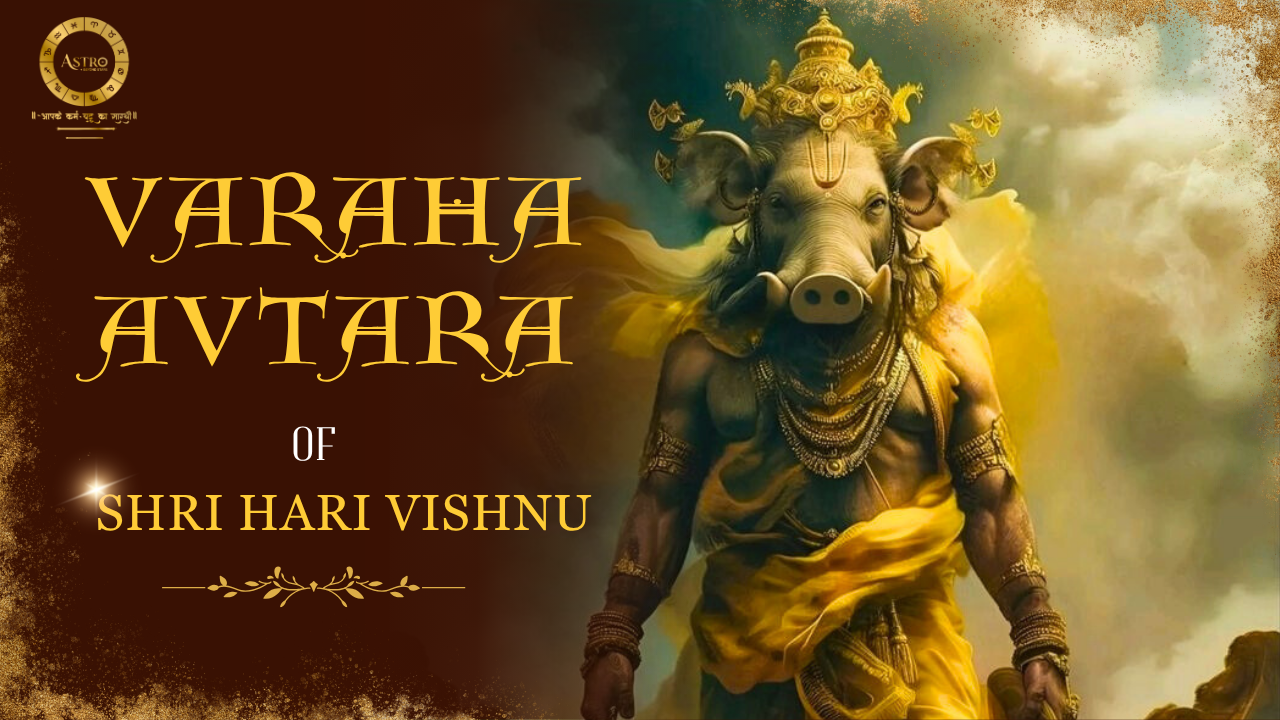Shri Hari took the Varahā Avtarā (a giant mighty boar). The story of Shri Vishnu’s Varaha Avatar is indeed a profound tale that highlights his role as the preserver of the cosmos and protector of Dharma. Varaha is the third avtar or incarnation of Shri Hari Vishnu and is depicted as a boar or a hybrid of a boar and human. Varaha incarnation symbolizes strength, resilience, and divine intervention during moments when cosmic balance is threatened.
The Story:
In ancient times, during the Satya Yuga, two demonic siblings, Hiranyaksha and Hiranyakashipu, emerged as a consequence of a curse placed by the four Kumaras—Sanaka, Sanandana, Sanatana, and Sanatkumara. The equilibrium of creation faced a grave threat from the formidable demon Hiranyaksha. He was born to the sage Kashyapa and his consort Diti, and was known as a powerful asura whose might and arrogance were unparalleled. Through rigorous penance, he acquired boons that rendered him invulnerable to both gods and mortals.
Brahma bestowed upon him the boon that he could not be slain by humans, gods, demons, or any other ordinary celestial beings. This boon fuelled Hiranyaksha’s arrogance, making him nearly invincible. Driven by pride, Hiranyaksha traversed the universe, instilling fear and challenging anyone who dared to confront him. His actions disrupted the cosmic order itself. In his pursuit of supremacy, he captured Bhumi Devi, the goddess representing Earth, and dragged her into the depths of the cosmic ocean. With the goddess displaced from her rightful position, the balance of creation was thrown into chaos, causing suffering for all living beings.
The Devas, unable to withstand Hiranyaksha’s overwhelming strength, turned to Shri Hari Vishnu for assistance. Responding to their pleas, the compassionate Shri Vishnu took the form of Varaha, a colossal boar. His divine physique was vast, with tusks gleaming like celestial weapons, and his roar echoed through the three realms, instilling both awe and hope in all. Varaha plunged into the cosmic ocean, his powerful body slicing through the waters effortlessly. As he descended, he found Bhumi Devi, who was submerged and in distress. With great tenderness, he lifted the goddess onto his tusks, cradling her with divine care and ensuring her safety. Furious at the sight of someone challenging his supremacy, Hiranyaksha confronted Varaha.
The two engaged in a fierce battle that reverberated throughout the universe. Hiranyaksha unleashed formidable weapons and spells, yet Varaha countered each assault with remarkable ease. Their confrontation was likened to a clash of cosmic forces. Hiranyaksha unleashed formidable weapons and incantations, yet Varaha effortlessly countered each assault. Their confrontation was characterized as a struggle between cosmic entities, representing chaos in opposition to the guardian of dharma. Ultimately, utilizing his divine might, Shri Vishnu (Varaha) delivered a decisive blow with his tusks, vanquishing Hiranyaksha and bringing an end to his reign of terror. The demise of the demon reinstated harmony and equilibrium within the cosmos. Subsequently, Lord Varaha tenderly restored Bhumi Devi to her rightful place, re-establishing the Earth in its proper orbit within the universe. Overcome with gratitude, Bhumi Devi extolled the Bhagwan’s boundless compassion and strength. In response, Lord Varaha reminded her of his unwavering commitment to safeguarding dharma and ensuring the welfare of all creation.
This narrative is found in the Bhagavata Purana and the Vishnu Purana, serving as a timeless testament to Shri Vishnu’s role as the preserver and the ever-compassionate guardian of dharma.
In the Bhagavata Purana and Vishnu Purana, this avatar carries deep metaphysical and symbolic meanings:
- Protection of Dharma: The Varaha Avatar demonstrates how Shri Vishnu intervenes to restore cosmic order whenever it is endangered by forces of adharma (unrighteousness), as represented by Hiranyaksha.
- Bhumi Devi’s Representation: Bhumi Devi, the goddess of Earth, represents nature and the material world. Her abduction into the cosmic ocean symbolizes the degradation or chaos inflicted upon the natural order by unchecked arrogance, greed, and abuse of power. Shri Vishnu’s act of lifting her from the depths reflects the restoration of balance and harmony in creation.
- The Mighty Boar: The form of a boar is significant. The boar, an animal known for its strength and ability to dig through the earth, symbolizes the power to unearth hidden truths and resolve deep-rooted problems. This choice of form emphasizes the divine’s adaptability and willingness to assume any shape necessary to protect creation.
- Hiranyaksha’s Arrogance and Its Downfall: Hiranyaksha’s boon, while granting him strength, became the cause of his arrogance. Like many demons in Hindu mythology, his downfall stemmed from forgetting that ultimate power lies with the divine. This illustrates that pride and misuse of power will inevitably lead to destruction.
- Cosmic Battle: The battle between Varaha and Hiranyaksha is not merely physical but also symbolic of the eternal struggle between dharma and adharma, order and chaos, selflessness and arrogance. Shri Vishnu’s victory signifies the triumph of divine will over egotistical forces.
This tale serves as a timeless reminder that, no matter how great the chaos, the divine is always there to restore balance and protect the welfare of all beings. It also underscores the importance of humility and living in harmony with the natural world.
NB: It is said that after being bestowed with strength by Shri Hari, Sharabha killed Narasimha first and then Varaha to enable Shri Hari Vishnu to re-absorb his energies that were in both the forms. To know about Sharabha, keep watching this space.




